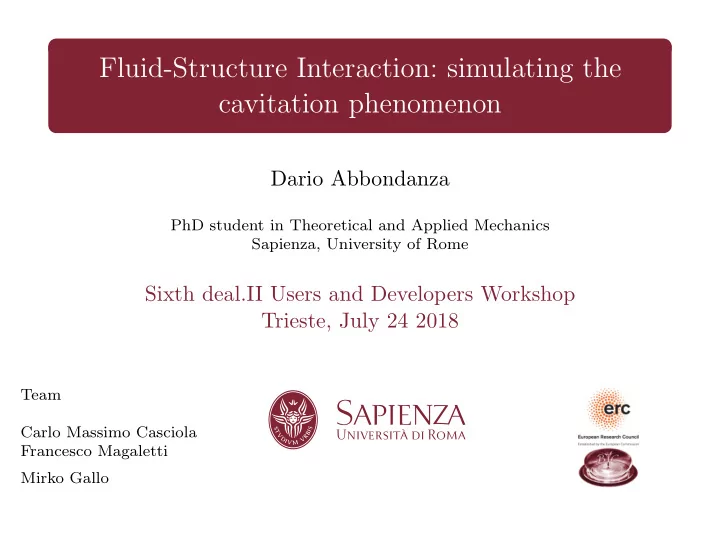

Fluid-Structure Interaction: simulating the cavitation phenomenon Dario Abbondanza PhD student in Theoretical and Applied Mechanics Sapienza, University of Rome Sixth deal.II Users and Developers Workshop Trieste, July 24 2018 Team Carlo Massimo Casciola Francesco Magaletti Mirko Gallo
Cavitation effects
Cavitation effects
Cavitation damage Philipp, A., & Lauterborn, W. (1998). Journal of Fluid Mechanics.
Diffuse Interface Model: Thermodynamics Van der Waals gradient approximation of the Helmholtz Equation of state P ( ρ, θ ) free energy functional: Van der Waals, IAPWS, etc. F = U − θS � � � f 0 ( ρ, θ ) + λ 2 |∇ ρ | 2 F ( ρ, ∇ ρ, θ ) = d V B f 0 ( ρ, θ ) is the classical bulk free energy density; 2 |∇ ρ | 2 The gradient term λ ρθ 1 − bρ − aρ 2 p 0 = R energetically penalizes sharp interfaces.
Diffuse Interface Model: Field Equations ∂ρ ∂t + ∇ · ( ρ u ) = 0 � � − p 0 + λ 2 |∇ ρ | 2 + ρ ∇ · ( λ ∇ ρ ) T = I + − λ ∇ ρ ⊗ ∇ ρ + ∂ρ u ∂t + ∇ · ( ρ u ⊗ u ) = ∇ · T µ ( ∇ u + ( ∇ u ) T ) − 2 3 µ ( ∇ · u ) I ∂E q e = − k ∇ θ + λρ ∇ ρ ∇ · u ∂t + ∇ · ( E u ) = ∇ · ( T · u − q e ) ρ Dˆ � λρ ∇ ρ ∇ · u − q e � + λρ ∇ ρ ∇ · u − q e s D t = ∇ · · ∇ θ θ θ 2 + 1 � � � � p 0 − λ 2 |∇ ρ | 2 − ρ ∇ · ( λ ∇ ρ ) T + I + λ ∇ ρ ⊗ ∇ ρ : ∇ u θ
Diffuse Interface Model: Field Equations ∂ρ ∂t + ∇ · ( ρ u ) = 0 � � − p 0 + λ 2 |∇ ρ | 2 + ρ ∇ · ( λ ∇ ρ ) T = I + − λ ∇ ρ ⊗ ∇ ρ + ∂ρ u ∂t + ∇ · ( ρ u ⊗ u ) = ∇ · T µ ( ∇ u + ( ∇ u ) T ) − 2 3 µ ( ∇ · u ) I ∂E q e = − k ∇ θ + λρ ∇ ρ ∇ · u ∂t + ∇ · ( E u ) = ∇ · ( T · u − q e ) The model handles liquid and vapor phases at the same time All physical quantities and behaviors are naturally embedded (e.g. surface tension, latent heat, phase changes, . . . )
Artificial thickening of the interface Less computational efforts ( µ mod − µ eq ) � ρ l ,ρ v = 0 � Mantaining the macroscopic physical � ρ l quantities unchanged (e.g. surface ( µ mod − µ eq ) d ρ = 0 tension, latent heat) ρ v � � d µ = 1 d P � � � � d ρ ρ d ρ � � ρ l ,ρ v ρ l ,ρ v � ρ l σ = λ ρ ′ ( x ) d ρ ρ v ρ l − ρ v h = max | ρ ′ ( x ) | Jamet, D., Lebaigue, O., Coutris, N., & Delhaye, J. M. (2001). Nuclear engineering and design.
How can deal.II help Ability to refine the mesh to obtain a better space resolution in the desired zone Possibility of studying the phenomenon in non-trivial domains Full coupling between fluid and structural part
Future perspectives Main objectives Have a working code to simulate the fluid behavior. Find a feasible description for real materials, to be used for simulating the material behavior (plasticity, viscoplasticity, crystal plasticity). Simulate the fluid-structure interaction.
Future perspectives Main objectives Have a working code to simulate the fluid behavior. Find a feasible description for real materials, to be used for simulating the material behavior (plasticity, viscoplasticity, crystal plasticity). Simulate the fluid-structure interaction. THANK YOU FOR YOUR ATTENTION
Recommend
More recommend